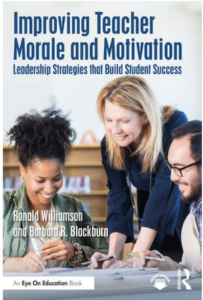Six Characteristics of a Learning-Focused School

Learning-focused schools are characterized by a collective growth mindset. It’s the inherent belief that every student can learn and grow, and that what you do as a teacher or school leader can make a difference.

Six Characteristics of Schools
with a Collective Growth Mindset
❑ We are learning oriented.
❑ We are willing to try new things.
❑ We collaborate.
❑ We emphasize mastery and learning.
❑ We focus on feedback and reflection.
❑ We own our mistakes and talk about them.
1. We are learning oriented.
The very heart of a growth mindset is an orientation toward learning. Growth requires learning. There are several ways to build a learning mindset in your school. First, make your focus clear through your words and actions. Explain a learning-oriented mindset and reinforce it in newsletters, emails, and meetings. One principal we worked with created a new tagline for his school, Ledbetter School is All About Learning.
It’s also important to hold everyone accountable for improvement. Talk with people about what they’ve recently learned. Ask them to share it with others. Reinforce improvement continually. Barbara worked with one principal who wanted his teachers to focus on learning during decision-making. They created a poster for his door:
Any time a teacher asked him for something, whether it was funding for additional resources, time for professional development, or a student activity, they were asked to justify their request based on the impact on student learning. The principal later shared with Barbara that over time this made a difference in how the school approached decision-making.
2. We are willing to try new things.
Too often, without meaning to, we discourage teachers from trying new things. Consider the faculty meetings where these comments from leaders were overheard.
“That’s a good idea. We should try it later.”
“We’ve never done it that way.”
“I don’t think our budget will allow that.”
“We tried that before and it didn’t work.”
Do these discussion stoppers sound familiar? If we want teachers to innovate, we need to provide a culture that supports innovation. Leaders need to model openness to new ideas. This includes being open and available to your teachers, listening without immediately rendering judgement, and asking questions to help them clarify their ideas.
Leaders who are open to new ideas provide support trying new things. This may include financial, physical, or human resources. Barbara worked with a middle school where a new teacher wanted to implement cooperative learning among his students. However, he was worried he would be reprimanded for issues with classroom management.
The principal worked with the curriculum facilitator, the assistant principal, and a teacher of special needs students to provide assistance with the management of groups. As the day progressed, the teacher thanked the others for their help, and, one at a time, asked them to leave.
He gradually increased his own leadership and management, and by the end of the day, was solely responsible for the lesson. As he told the principal, “I wouldn’t have been able to do it unless you provided help. I was able to wade into the new type of lesson rather than jumping in the deep end.”
3. We collaborate.
The opportunity to collaborate is important when supporting a growth mindset. Groups, when structured appropriately and when following collaborative norms, are more likely to focus on growth and positive movement.
Let’s think about it this way. Groups that are stuck in a fixed mindset focus on the past, use checklists for tasks, and celebrate individual accomplishments. With a growth mindset, diverse perspectives are celebrated. There is a culture of trust and the sense that everyone is contributing to the group goal. The overall focus is on impacting others.
As you think about this comparison and compare it to aspects of your culture, you’ll see that the collaboration emerging from being growth mindset-oriented benefits your faculty and staff and students.
As Carol Dweck points out, “When entire companies embrace a growth mindset, their employees report feeling more empowered and committed; they also receive far greater organizational support for collaboration and innovation.”
4. We emphasize mastery and learning.
Across the nation many schools have a focus on short-term achievement rather than growth. If you work in a state that mandates that type of outlook, it’s difficult to shift the perspective. However, it’s critical to provide options for teachers to emphasize mastery and learning, rather than focusing on test scores or simply jumping from task to task.
We recommend the use of Lesson Studies, which provides an opportunity for collaboration and reflection. Originally used by Japanese teachers, lesson studies emphasize working in small groups to plan, teach, observe, and critique a lesson.
A Lesson Study involves groups of teachers in a collaborative process designed to systematically examine their practice with the goal of becoming more effective, which inherently focuses on growth mindset. Here is a short description of the Lesson Study Protocol. At the end you’ll find a link to a PDF from Education Northwest that offers an excellent tool to begin using this process in your school.
Lesson Study Protocol
- Participants should be volunteers but the invitation to participate should be inclusive.
- While working on a study lesson, teachers work together to develop a detailed plan for the lesson.
- One member of the group teaches the lesson in a real classroom while other members of the group observe the lesson.
- The group comes together to discuss their observations about the lesson and student learning.
- The group works together to revise the lesson.
- Another teacher teaches the revised lesson while group members observe.
- The group reconvenes to discuss the observed lesson.
- The revision process may continue as long as the group believes it is necessary.
- Teachers talk about what the study lesson taught them and how they can apply the learning to their own classroom. They may prepare a report to be shared with others.
To learn more about conducting a lesson study, download this free Education Northwest PDF.
5. We focus on feedback and reflection.
As you consider the aspects of collective growth mindset we’ve discussed so far, you’ll notice that reflection and feedback are a part of each characteristic. Both components are foundational to growth mindset, and you’ll want to make sure not only that they are integral to your efforts, but that your school positively reinforces teachers who incorporate them.
Teacher reflection and feedback are most likely to be present in your school during observations and during post-observation conferences. That’s essential but not sufficient. We should always encourage teachers to make a habit of reflecting on their everyday teaching and giving themselves “feedback” in a teaching notebook, private digital diary – whatever works for them.
The ability to self-diagnose their work, to reinforce what worked and to adjust what didn’t, is a key part of valuing growth over mere task completion.
Here are some simple reflection questions that can become part of daily “diagnosis.”
- An effective part of the lesson was…
- Students responded well to…
- Students struggled with…
- I was surprised by…
- I would adapt…
- I would keep…
- I might share with parents…
6. We own mistakes and talk about them.
Finally, it’s important for your teachers, as groups and individually, to talk about things that didn’t go well and own their part of that. One school we worked with had a section of their electronic management resource called “Educational Encounters.” Teachers posted new ideas they learned about and tried – and what worked and what didn’t.
You might guess that their successes generated the most discussion, but the opposite occurred. Once teachers began to share about their failures, other teachers were encouraging and enthusiastic about how everyone could learn from the mistakes. Another school used a similar method in the faculty workroom, calling it “Marvelous Mistakes.” The focus was on how to learn from the experience, not the fact that something didn’t work.
Final thoughts
It’s critical for a school leader to possess a growth mindset for students, for teachers and for themselves. When they do so, they model behaviors that reinforce the positive traits associated with learning and growth. They talk about their own learning, cultivate a collaborative environment, and use any opportunity to reinforce the importance of growing as professionals every day.

Dr. Ronald Williamson is Professor Emeritus of Educational Leadership at Eastern Michigan University. He is a former principal, central office administrator and executive director of the National Middle School Association (now AMLE). The author of numerous books on leadership, Ron is the co-author with Barbara R. Blackburn of 7 Strategies for Improving Your School (2020) from Routledge/Eye On Education.
Dr. Barbara R. Blackburn, a “Top 10 Global Guru in Education,” is a bestselling author of over 30 books and a sought-after consultant. She was an award-winning professor at Winthrop University and has taught students of all ages. In addition to speaking at conferences worldwide, she regularly presents virtual and on-site workshops for teachers and administrators. Barbara is the author of Rigor in Your Classroom: A Toolkit for Teachers, Second Edition (Routledge/EOE, 2023).






























